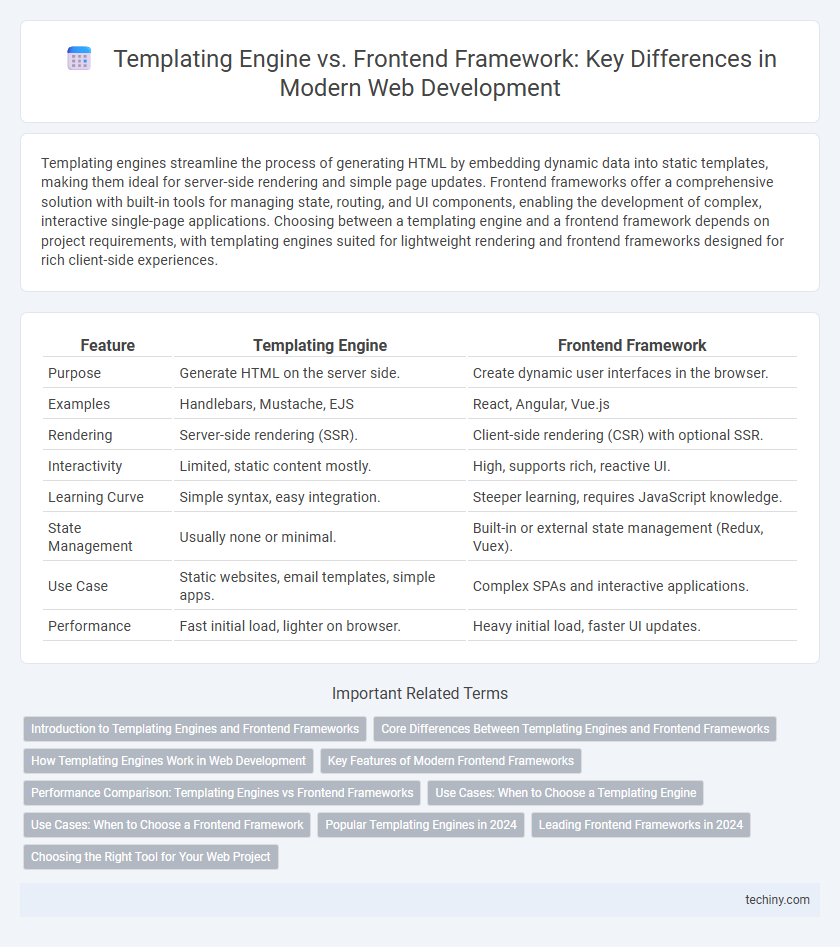Templating engines streamline the process of generating HTML by embedding dynamic data into static templates, making them ideal for server-side rendering and simple page updates. Frontend frameworks offer a comprehensive solution with built-in tools for managing state, routing, and UI components, enabling the development of complex, interactive single-page applications. Choosing between a templating engine and a frontend framework depends on project requirements, with templating engines suited for lightweight rendering and frontend frameworks designed for rich client-side experiences.
Table of Comparison
| Feature | Templating Engine | Frontend Framework |
|---|---|---|
| Purpose | Generate HTML on the server side. | Create dynamic user interfaces in the browser. |
| Examples | Handlebars, Mustache, EJS | React, Angular, Vue.js |
| Rendering | Server-side rendering (SSR). | Client-side rendering (CSR) with optional SSR. |
| Interactivity | Limited, static content mostly. | High, supports rich, reactive UI. |
| Learning Curve | Simple syntax, easy integration. | Steeper learning, requires JavaScript knowledge. |
| State Management | Usually none or minimal. | Built-in or external state management (Redux, Vuex). |
| Use Case | Static websites, email templates, simple apps. | Complex SPAs and interactive applications. |
| Performance | Fast initial load, lighter on browser. | Heavy initial load, faster UI updates. |
Introduction to Templating Engines and Frontend Frameworks
Templating engines generate dynamic HTML by embedding variables and logic directly within templates, simplifying server-side rendering processes in web development. Frontend frameworks like React, Angular, and Vue provide structured environments for building interactive user interfaces through components, state management, and reactive data binding. Choosing between templating engines and frontend frameworks depends on project requirements such as complexity, interactivity, and rendering strategy.
Core Differences Between Templating Engines and Frontend Frameworks
Templating engines primarily generate HTML dynamically on the server or client by injecting data into predefined templates, focusing on content rendering without managing application state. Frontend frameworks, such as React, Angular, or Vue, offer comprehensive solutions that include component-based architecture, state management, routing, and direct DOM manipulation for building interactive user interfaces. The core difference lies in templating engines' role as rendering tools versus frontend frameworks' role as full-fledged application frameworks enabling complex UI development and user experience control.
How Templating Engines Work in Web Development
Templating engines in web development process templates by dynamically embedding data into HTML structure, enabling efficient rendering of web pages with variable content. They parse template files and replace placeholders with server-side data before sending the fully rendered HTML to the client. This approach simplifies content management and enhances performance by offloading rendering tasks from the client to the server.
Key Features of Modern Frontend Frameworks
Modern frontend frameworks like React, Angular, and Vue.js offer dynamic component-based architecture, enabling reusable UI elements and efficient state management. They support reactive data binding, virtual DOM for high performance rendering, and integration with RESTful APIs or GraphQL for seamless backend communication. These frameworks facilitate modular code organization, built-in routing, and extensive developer tooling, enhancing scalability and maintainability compared to traditional templating engines.
Performance Comparison: Templating Engines vs Frontend Frameworks
Templating engines typically offer faster initial rendering by directly converting templates to HTML with minimal overhead, making them ideal for static content or server-side rendering scenarios. Frontend frameworks, while introducing runtime complexity due to virtual DOM diffing and state management, excel in dynamic and interactive applications by efficiently updating the UI in response to user actions. Performance benchmarks show templating engines outperform frameworks in lightweight use cases, but frameworks provide superior responsiveness and maintainability in complex, state-driven environments.
Use Cases: When to Choose a Templating Engine
Templating engines are ideal for server-side rendering of HTML where dynamic content needs to be injected efficiently, such as in traditional web applications with minimal client-side interaction. They excel in scenarios requiring fast page loads, SEO optimization, and simpler development workflows without extensive JavaScript. Choose a templating engine when building content-focused websites, email templates, or lightweight applications where backend control over markup is paramount.
Use Cases: When to Choose a Frontend Framework
Frontend frameworks like React, Angular, and Vue.js excel in building complex, interactive single-page applications (SPAs) requiring dynamic user interfaces and real-time data updates. They provide robust state management, component-based architecture, and seamless integration with APIs, making them ideal for projects involving extensive client-side logic and user interaction. When scalability, maintainability, and rich UI experience are priorities, opting for a frontend framework ensures optimal performance and developer productivity over traditional templating engines.
Popular Templating Engines in 2024
Popular templating engines in 2024 such as Handlebars.js, EJS, and Pug offer efficient server-side rendering by dynamically generating HTML with minimal client-side processing. These templating engines simplify the integration of data into static templates, providing fast initial page loads and SEO benefits compared to frontend frameworks like React or Vue.js. Choosing a templating engine is ideal for projects prioritizing performance, SEO, and straightforward content rendering over complex state management and interactivity.
Leading Frontend Frameworks in 2024
Leading frontend frameworks in 2024, such as React, Vue.js, and Angular, dominate web development by providing robust, component-based architectures that enhance user interface interactivity and maintainability. Templating engines like Handlebars or EJS primarily handle HTML rendering on the server side, focusing on simplicity and speed without the complex state management offered by frontend frameworks. These modern frameworks excel in managing dynamic content and complex application states, making them essential for building scalable, high-performance web applications.
Choosing the Right Tool for Your Web Project
Templating engines like Handlebars and EJS excel in rendering dynamic HTML on the server side, offering simplicity and fast performance for small to medium-sized projects. Frontend frameworks such as React, Vue, and Angular provide robust component-based architectures, state management, and interactive user interfaces suited for complex and scalable web applications. Selecting the right tool depends on project requirements, team expertise, and the desired balance between backend rendering efficiency and frontend interactivity.
Templating Engine vs Frontend Framework Infographic

 techiny.com
techiny.com